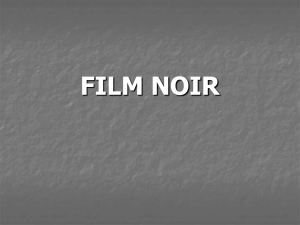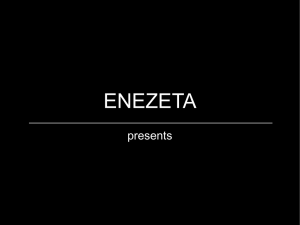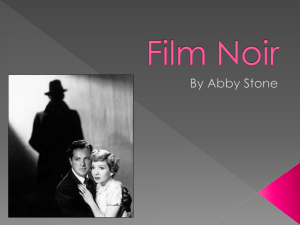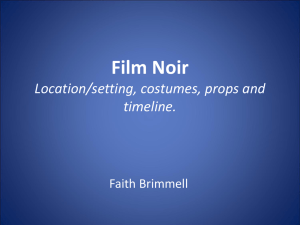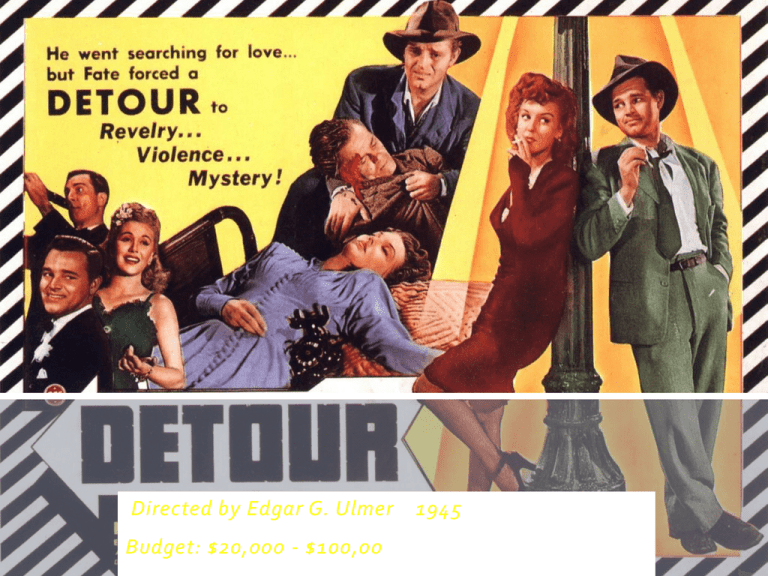
Directed by Edgar G. Ulmer
Budget: $20,000 - $100,00
1945
PLOT SUMMARY:
Piano player Al is bitter about having to work in a New York nightclub. After his girlfriend
Sue leaves to seek fame in Hollywood, he decides to join her. With little money, he has to
hitchhike his way across the country.
In Arizona, bookie Charles Haskell Jr. gives him a ride in his convertible. Haskell dies in his
sleep while Al is driving after popping a number of unidentified pills. Unable to rouse
Haskell, Al opens the passenger-side door. Haskell falls out and strikes his head on the
ground. Al then realizes the bookie is dead. Fearful that the police will believe he killed
Haskell, Al dumps the body off the side of the road, takes Haskell's money, clothes and
identification, then drives away. After spending the night in a motel, Al picks up another
hitchhiker, Vera, at a gas station. By sheer bad luck, it turns out that the femme fatale had
also been picked up by Haskell earlier. She scratched him deeply in the arm and got out
after he tried to become too friendly. When Al identifies himself as Haskell, she blackmails
him by threatening to turn him in.
Vera learns from a newspaper that Haskell's wealthy father is near death and looking for his
son. Vera demands that Al impersonate Haskell, but Al refuses. Back in the apartment, Vera
gets drunk, and they begin arguing. She threatens to call the police, running into the
bedroom with the telephone and locking the door. She falls into a stupor on the bed, with
the telephone cord tangled around her neck. Al tries to break the cord. Then, when he
breaks down the door, he sees that he has accidentally strangled her. He goes hitchhiking
again, but is picked up by the police.
TECHNICAL CONVENTIONS OF NOIR:
a)Expressionist Camerawork and Lighting
Cinematography:
• Skewed/canted angles
• Deep focus
• Disorientating visual schemes
Lighting:
• Low-Key / High contrast –
expressionistic.
• Lighting creates deep ominous
shadows and sharp highlights
Contribution to meaning:
• Visually a dark, uneasy, unsettled cinematic
world – creates a sense of claustrophobia,
entrapment and menace. Characters are
trapped in a world of doom.
• Visually a metaphor for the underlying themes
of paranoia and anxiety that pervade film noir.
Relationship to Society: Influences
• Reflects the influence of German émigré directors (such
as Ulmer, Wilder) who had been practitioners / students
of Expressionist filmmaking in Germany before their
escape to America.
• Noir films are visual metaphors used to communicate
the ‘darkness’ in American society during the time of
World War Two and the devestation caused by the
stockmarket crash in 1929, and the ensuing economic
depression.
GERMAN EXPRESSIONISM: 1920’s
The German Expressionist movement was largely confined to Germany due to the
isolation the country experienced during World War I. In 1916, the government had
banned more foreign films in the nation. The demand from theatres to generate films led
film production to rise from 25 films (1914) to 130 films (1918). German Expressionists
directors film felt disillusioned with reality and the world around them. As a result they
made films that looked warped and distorted and were extremely surreal. German
expressionist directors then took their disillusionment one step further by having heavy
and stark shadows, depressed/dark stories, and corruptible and untrustworthy
characters. As many Germans had felt betrayed by their government when World War I
had concluded many German Expressionist directors projected authority figures as
villains to convey a sense of how no one could be trusted in the world they were living in.
The first Expressionist films made up for a lack of lavish budgets by using set designs with
wildly non-realistic, geometrically absurd sets, along with designs painted on walls and
floors to represent lights, shadows, and objects. The plots and stories of the Expressionist
films often dealt with madness, insanity and betrayal (as opposed to standard actionadventure and romantic films).
German Expressionism was an answer to the grim reality of daily life. But it was not so
much a direct relay of life to art. It was a way to represent and bring across the reality few
could imagine. Sex, murders, depression, veterans ghoulishly mangled in the war, the
loss of innocence and complete rejection of the past were the things the German people
dealt with during the post-war years of 1919 – 1929..
EXPRESSIONIST STYLE:
The “German style.” Emphasis on design or mise-en-scène, uncanny atmosphere,
and composition (less on story and editing, unlike Hollywood).
“The film image must become graphic art” (Hermann Warm).
Expressionism = Stylization that abstracts and transforms reality.
- photography (unexpected camera angles, little camera movement)
- lighting (stark contrasts of light and shadow for various effects)
- totally artificial, stylized sets (“paintings come to life”), stripped of all realistic
details and psychology—sets that become
symbolic diagrams of emotional states
- overtly theatrical (anti-naturalist) acting style (actors move in jerky, slow, sinuous
patterns) and heavy make-up
- integration of all elements of mise-en-scène to create an overall composition
Such Expressionist techniques aim to:
- evoke mystery, alienation, disharmony, hallucination, dreams, extreme emotional
states, destabilization
INFLUENCE ON FILM NOIR:
The extreme realism of Expressionism was short-lived, fading away after
only a few years. However, the themes of Expressionism were integrated
into later films of the 1920s and 1930s, resulting in an artistic control over
the placement of scenery and light to enhance the mood of a film. This dark,
moody school of film making was brought to the United States when the
Nazis gained power and a number of German filmmakers emigrated to
Hollywood. These German directors found U.S. movie studios willing to
embrace them, and several German directors and cameramen flourished
there, producing a repertoire of Hollywood films that had a profound effect
on film as a whole.
Two genres that were especially influenced by Expressionism are horror film
and film noir. German filmmakers such as Karl Freund (the cinematographer
for Dracula in 1931) set the style and mood of the Universal monster movies
of the 1930s with their dark and artistically designed sets, providing a model
for later generations of horror films. Directors such as Fritz Lang, Billy
Wilder, Alfred Hitchcock and Orson Welles, introduced the Expressionist
style to crime dramas of the 1940s, expanding Expressionism's influence on
modern film making.
SOCIAL AND ECONOMIC INFLUENCE
THE GREAT DEPRESSION AND THE
STOCK MARKET CRASH 1929
How is this event reflected in Al’s
voiceover narration in ‘Detour’?
“Even after hawking everything I
only had enough money to eat.
Money. You know what that is. It’s
the stuff you never have enough
of. Little green things with
George Washington’s picture that
men slave for, commit crimes for,
die for. It’s the stuff that has
caused more trouble in the world
than anything else we ever
invented, simply because there’s
too little of it. At least I had too
little of it. So it was me for the
thumb”
DINER SCENE:
Expressionistic lighting is used on Al’s
face as he begins his interior
monologue. The dark surrounding and
spotlight on his eyes acts as a focal
point for audiences as he reveals the
source of his despair.
It is a visual metaphor for his
darkened, melancholy state of mind
and reflects his woeful fate.
Triangular shot composition is used in
this scene. The cluttered mis-en-scene
of the diner is also a reflection of the
entrapment Al feels
Vera’s murder scene:
Vera’s Murder Scene
• Like the Diner scene, the expressionistic cinematography and lighting is used
to visual communicate Al’s confused and tortured state of mind. His accidental
murder of Vera has destroyed all hope of a life with Sue. He is also now guilty
of murder rather than simply identity theft and is distraught at this thought of
the crime he has committed.
• The low-key lighting also creates canted shadows on the walls of the
apartment as Vera attempts to run into her bedroom. Further reflecting the
impending danger and establishing a sense of unease in the viewer. These are
also evident on the walls of the bedroom as we see Vera’s dead body.
• The shifts in focus as Al looks from Vera to her possessions (perfume, shoes)
and eventually the telephone cord reflect the emotional turmoil he is
experiencing.
• Deep shadows are shown on the face of Al as he flees the apartment reflecting
his internal moral struggle.
Film Noir Stock Characters:
The flawed hero / anti-hero = Al
At the least, the Noir protagonist
is morally ambiguous / flawed :
willing to commit crime (adultery
& murder) for their own gain
They were cynical, tarnished,
obsessive (sexual or otherwise),
brooding, menacing, sinister,
sardonic, disillusioned, frightened
and insecure loners (usually men),
struggling to survive - and in the
end, ultimately losing.
Often ‘haunted by the past’ –
either explicitly stated or implied.
Relationship to Society: Influences:
• In a world confronted by the horrors of World War II, the
atrocities of the Holocaust and the vanguard of
psychology/psychiatry the flawed male protagonist in Noir is
a character study of the human mind and human spirit – the
essential evil that potentially exists in all of us.
• Often times the psychologically damaged Noir protagonist is
equated to the psychologically damaged veterans returning
from the war – they had witnessed first-hand unimaginable
atrocities.
• Rather than being the ‘all-American guy’ who upholds
traditional societal values, the Noir protagonist
metaphorically represents the threat to good wholesome
society that the ‘man alone’ produces.
Contribution to meaning:
At the heart of Film Noir is
the flawed male who is the
embodiment of fatalism and
doom which define the
genre.
Some protagonists are
‘everyday Joes’ who seem to
be pulled into a web of
destruction, others can’t
help but contribute to their
own demise.
Evidence from Detour:
Al is the lovelorn loner who
makes one bad decision after
another: he digs himself a hole
too big to extract himself from
before he even realises.
Fate has picked him to be the
‘fall guy’ and he reluctantly
accepts his fate once he has
lost everything: his lover (Sue),
his identity/ies (Al Roberts),
and his innocence (murdering
Vera)
Femme Fatale
The independent,
strong-willed, sexually
empowered, duplicitous
woman who compels
the protagonist to
commit a crime with/for
her.
Contribution to meaning:
The quintessentially evil
Noir woman – she occupies
the hub of the narrative
and represents the worst
type of female imaginable
(at that time)
The femme fatale drives
the narrative, but in the
end she is always punished
(usually by death) for her
transgressions of societal
‘laws’.
Relationship to Society: Influences:
During the war/Post-war years,
the femme fatale represented
the ultimate threat to ‘civil’
society – the independent
woman who has no interest in
family, homemaking or, wifely
duties. Thus, the femme fatale
is always punished.
Noir is essentially a
misogynistic genre: the demise
of the femme fatale becomes a
strong message to women to
avoid modelling themselves on
the femme fatale.
Evidence from Detour:
• Write down how
the character of
Vera fulfils this role.
• Support your ideas
with specific
evidence from the
film
• Remember the film
is also on Youtube
for your viewing
pleasure!
Narrative Conventions of Film Noir
Convoluted / Complex / Twisting Narrative
• Often told in flashback with jumps in time and
location – a subjective ‘retelling’ of the
narrative
• Protagonist is often confused about the ‘next
step’ – this increases the audiences
reaction/interaction with the film
• Can have multiple simultaneous plotlines – an
unravelling mystery.
Contribution to meaning:
•
Creates a subjective interaction between the
narrative and the audience – engages the viewer
in the mystery (also helps audience alignment
with the ‘confused’ protagonist).
•
Creates tension, suspense, …
•
Non-linear narratives reinforce the overriding
theme of fate: the fate of the characters is sealed
from the beginning of the film: the narrative
serves to reveal how they got to that position
•
The protagonist is revealed ‘in parts’ as the
narrative unravels.
Relationship to Society: Influences:
Reflects the confusion,
paranoia and doubt that
pervaded American
society during the war
years.
Reflects plot devices of
pulp fiction writers
(Hammett, Chandler, …)
on whose work many
films noir are based.
Evidence from Detour:
Al’s life takes a
‘detour’ and he
quickly loses control
of where he is going:
at every turn a new
disaster awaits him.
1st Person Subjective Voice-Over
Noir films are often told in flashback from the
perspective of the protagonist – his fate is already
sealed and the voice-over recounts how he came
to be in that position.
A thought: as the protagonist is a morally
ambiguous figure, can we trust his ‘version of
events’ – often positioning himself as the hapless
victim of circumstance.
Contribution to meaning:
Voice-over helps build a sense of character for the
protagonist - voice-over narration film noir
characteristic represents psychological reflection
and introspection by a character
Voice-over often brings some sense to the
twisting/convoluted narrative – provides a link
between the events.
Relationship to Society: Influences:
Sometimes related to
the use of voiceover in
documentaries – a voice
of authority that brings
insight to situations.
Likened to the voice of
the many ‘looking for
reason’ and explanation
in the war / post-war
environment.
Evidence from Detour:
Al’s interior monologue and
deliberations on his fate
provide the backbone of the
narrative and provide an
explanation for his
predicament.
Provide your own examples
of this interior monologue.
THEMATIC CONVENTIONS:
Paranoia / Disillusionment / Anxiety /Fate
Fatalism is expressed by one transgression
that spirals out of control. The average
citizen character makes a mistake that
snowballs into much greater problems.
Every attempt at correction just makes
everything worse. This is often called a
spider web of deceit in film noir. It can
suggest hysteria and panic.
Contribution to meaning:
The protagonist in
particular and the
whole narrative
structure feeds
themes of Paranoia,
Disillusionment,
Anxiety and Fate.
Relationship to Society: Influences:
• War / Post-War society – the threat to
humanity
• The horrors of the Holocaust revealed
• The threat of nuclear annihilation
• The birth of psychology / psychiatry /
psychoanalysis – a questioning of the
human brain and human nature (as
possibly driven by evil).
Evidence from Detour:
Whole narrative centres
around Al being pushed
off his chosen path – onto
a ‘detour’ in which ‘fate’
has tripped him up – he is
the innocent victim of
fate(?)
Give specific examples of
where this is shown in the
film.

